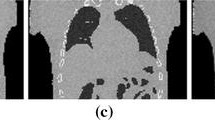Abstract
Objectives
To simulate cardiac malpositions, leftward and rightward shift and dextrocardia, and also to compare distribution of activity of septal and lateral walls of left ventricle acquired in standard acquisition arc and after relevant adjustment.
Methods
In this study, digital phantoms with cardiac malpositions are designed and procedure of acquisition of scan in standard arc (from right anterior oblique to left posterior oblique) and adjusted acquisition arc is simulated. The three situations of malposition including leftward and rightward shift and dextrocardia are considered. For all types, acquisition is conducted in standard and then adjusted arcs (from anterior to posterior and also from right to left for leftward and rightward shifts, respectively, and for dextrocardia, from left anterior oblique to right posterior oblique). All obtained projections are reconstructed using the algorithm of filtered back projection. During forward projection to obtain sinograms, radiation attenuation is also modeled by incorporation of a simplified transmission map to emission map. The resulting tomographic slices of the LV (septum, apex, and lateral wall) are presented visually and are compared by plotting intensity profiles of the walls. Finally, normalized error images are also computed. All the computations are performed in MATLAB software package.
Results
In transverse slice, septum and lateral wall are attenuated progressively from apex, which is closer to the camera, to the base in similar fashion. In tomographic slices of standard acquisition arc, the septum shows remarkably higher activity compared to lateral wall. However, after adjustment, both seems equally intense and progressively being attenuated from apex to base, similar to that found in phantom with normally positioned heart. Likewise, for the phantom with rightward shift, when the scanning was done in standard arc, the septum is more intense than the lateral wall. And similarly, adjustment of the arc renders both walls equally intense. In dextrocardia, level of attenuation of basal parts of septum and lateral wall is higher in 360° arc compared to adjusted 180° arc.
Conclusion
Adjustment of acquisition arc exerts perceptible changes in distribution of activity over LV walls which are more compatible with normally positioned heart.











Similar content being viewed by others
Abbreviations
- SPECT:
-
Single-photon emission computed tomography
- LV:
-
Left ventricle
- RAO:
-
Right anterior oblique
- LPO:
-
Left posterior oblique
- FBP:
-
Filtered back projection
References
Dorbala S, Ananthasubramaniam K, Armstrong IS, Chareonthaitawee P, DePuey EG, Einstein AJ. Single Photon Emission Computed Tomography (SPECT) myocardial perfusion imaging guidelines: Instrumentation, acquisition, processing, and interpretation. J Nucl Cardiol 2018;25:1784‐846.
Verberne HJ, Acampa W, Anagnostopoulos C, Ballinger J, Bengel F, De Bondt P, et al. EANM procedural guidelines for radionuclide myocardial perfusion imaging with SPECT and SPECT/CT: 2015 revision. Eur J Nucl Med Mol Imaging 2015;42:1929‐40.
Qutbi M. SPECT myocardial perfusion imaging in patients with dextrocardia. J Nucl Cardiol 2019;26:1197‐204.
Ozdemir S, Gazi E. Myocardial perfusion spect imaging in dextrocardia: A case report. Mol Imaging Radionucl Ther 2013;22:70‐2.
Qutbi M, Soltanshahi M, Ansari M, Hashemi H, Neshandar Asli I, Shafiei B. Quantitation in Dextrocardia on myocardial perfusion imaging: How to perform quantitative analysis using Cedars-Sinai software. Nucl Med Rev Cent East Eur 2018;21:50‐2.
Figal M. CT Reconstruction. In: Birkfellner W, editor. Applied medical image processing: A basic course. New York: CRC Press; 2014. p. 339‐70.
Cobelli C, Carson E. Introduction to modeling in physiology and medicine. London: Elsevier; 2019.
Gordon SI, Guilfoos B. Introduction to modeling and simulation with MATLAB and python. Boca Raton: Taylor & Francis Group; 2017.
International Atomic Energy Agency (2014) Diagnostic Radiology Physics, Non-serial Publications, IAEA, Vienna. https://www.iaea.org/publications/8841/diagnostic-radiology-physics. Accessed Jan 2023
International Atomic Energy Agency (2015) Nuclear Medicine Physics, Non-serial Publications, IAEA, Vienna. https://www.iaea.org/publications/10368/nuclear-medicine-physics. Accessed Jan 2023
Nakajima K, Okuda K, Kawano M, Matsuo S, Slomka P, Germano G, et al. The importance of population-specific normal database for quantification of myocardial ischemia: Comparison between Japanese 360 and 180-degree databases and a US database. J Nucl Cardiol 2009;16:422‐30.
He X, Links JM, Gilland KL, Tsui BM, Frey EC. Comparison of 180 degrees and 360 degrees acquisition for myocardial perfusion SPECT with compensation for attenuation, detector response, and scatter: Monte Carlo and mathematical observer results. J Nucl Cardiol 2006;13:345‐53.
Qutbi M, Soltanshahi M. The impact of patient-to-detector distance on LV volumes and TID index on SPECT myocardial perfusion imaging: Emphasis on consistent patient-detector positioning in stress and rest phases. J Nucl Cardiol 2019;26:333‐6.
Huang K, Feng Y, Liu D, Li W, Liang W, Li L. Different acquisition arcs for better imaging left ventricular wall in myocardial perfusion single photon emission tomography. Hell J Nucl Med 2018;21:134‐9.
Sarrut D, Bala M, Bardies M, Bert J, Chauvin M, Chatzipapas K, et al. Advanced Monte Carlo simulations of emission tomography imaging systems with GATE. Phys Med Biol 2021;66:10TR03.
Author information
Authors and Affiliations
Corresponding author
Ethics declarations
Disclosures
The author, Mohsen Qutbi, has no conflict of interest relevant to this work to disclose.
Additional information
Publisher's Note
Springer Nature remains neutral with regard to jurisdictional claims in published maps and institutional affiliations.
Supplementary Information
Below is the link to the electronic supplementary material.
Rights and permissions
Springer Nature or its licensor (e.g. a society or other partner) holds exclusive rights to this article under a publishing agreement with the author(s) or other rightsholder(s); author self-archiving of the accepted manuscript version of this article is solely governed by the terms of such publishing agreement and applicable law.
About this article
Cite this article
Qutbi, M. Adjustment of acquisition arc in cardiac malposition during myocardial perfusion SPECT imaging: computer simulation based on deterministic modeling. J. Nucl. Cardiol. 30, 1910–1921 (2023). https://doi.org/10.1007/s12350-023-03266-8
Received:
Accepted:
Published:
Issue Date:
DOI: https://doi.org/10.1007/s12350-023-03266-8




